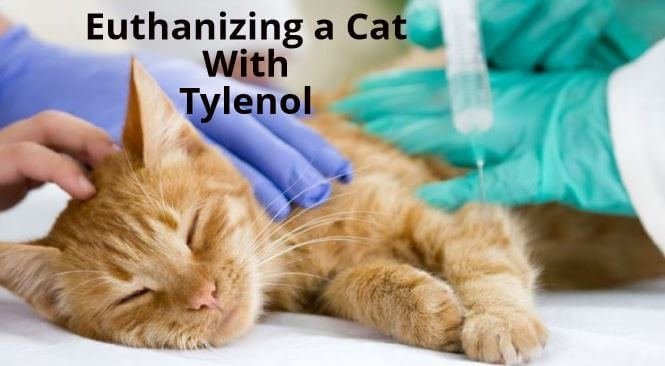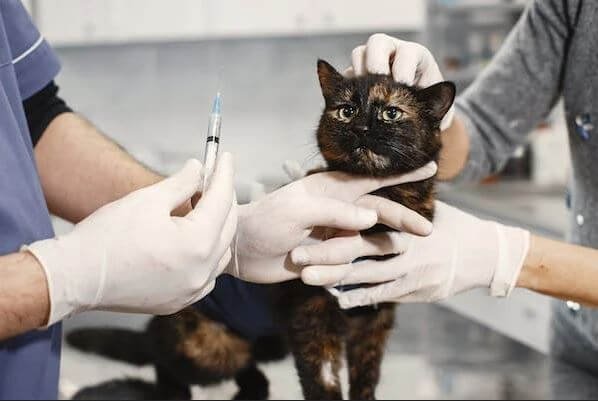Whether your cat suffers from old age degenerative disorders, behavioral disease, or untreatable aggression that endangers other family members, humane euthanasia is a great way to take him out. Many pet parents have turned to Tylenol for euthanasia. However, before going that route, do you know how to euthanize a cat at home with Tylenol?
You can euthanize a cat at home with Tylenol with proper planning and preparation. Once everything is on order, sedate the cat with a reliable drug like gabapentin before administering Tylenol. However, you should consult your vet and familiarize yourself with local laws and regulations around home euthanasia before undertaking these steps.
In this guide, you’ll learn five crucial steps to follow when euthanizing a cat at home with Tylenol. We’ll also discuss why it’s a bad idea, and that you don’t have to do it. Stay tuned!
Euthanizing a Cat at Home With Tylenol: Is It Humane?

Euthanizing a cat at home with Tylenol is inhumane. If you believe your cat is in great distress and should be euthanized, contact your veterinarian to use their expertise to take the cat out humanely and legally.
Often, home euthanasia with medications like Tylenol is extremely slow and inhumane. Instead of helping your cat, you add to their suffering and misery because Tylenol takes 18 to 36 hours to kill a cat.
Therefore, while Tylenol can kill a cat if injected with the poison, it’s not a humane option. Additionally, a botched euthanasia with Tylenol could result in the following repercussions:
- Seizures
- Coma
- Bloody diarrhea
- Vomiting
- Difficulty breathing
Find Out: How to Euthanize a Cat With Over-the-Counter Drugs: 2 Easy Ways
Seeing your cat experience these symptoms due to Tylenol is not only distressing but also painful and inhuman. That’s why as a responsible pet parent, seeking the services of a professional and licensed veterinarian is essential.
Most vets would never recommend Tylenol—leave alone euthanizing your pet at home. Additionally, most states prohibit home euthanasia procedures. Therefore, you should consult local authorities to understand the rules and regulations.
That said, we can attribute the temptation to try in-home euthanasia primarily to financial limitations. Usually, this procedure may cost quite a lot of money.
However, if you’re in limbo, you can still negotiate with your vet for a fair price. Alternatively, you can take your animal to a local animal shelter for euthanasia.
In summary, don’t undertake the procedure at home. If you are confused, you can contact the Animal Poison Center, which can advise you accordingly.
Can Tylenol PM Kill a Cat?
Tylenol PM can kill a cat if administered in lethal doses like 50-100 mg/kg.
According to experts, cats and other felines don’t metabolize Tylenol effectively, leading to toxicity. Once the cat swallows the tablet, reaching the bloodstream takes only 30 minutes.
Tylenol PM contains a compound called acetaminophen, the main cause of toxicity. Once the cat ingests this drug, the following things happens:
- Red blood cells fail to carry and transport oxygen – also called methemoglobinemia happens between 4-12 hours.
- Liver damage
- Cat becomes weak and depressed
- Cat experiences rapid breathing
- Pulse rate increases
- The animal may start to pant
- The cat experiences intense abdominal pain
- Vomiting
- Drooling
- The cat that ingested the drug stops eating
- Swelling in the face for some cats
If you administer the wrong amount of the drug, expect your cat to undergo the symptoms indicated above for a week, after which it will succumb due to multiple organ failure. What this means for your cat is plenty of suffering and torture before death—which is inhumane.
However, the cat dies within 18-36 hours with the correct amount of the drug. But methemoglobin concentrations should exceed 50% for a quicker death.
Also Read: How to Comfort a Dying Cat in 6 Simple Ways
How to Euthanize a Cat at Home With Tylenol and Why You Don’t Have To

Here are the five critical steps you should follow to euthanize your cat at home with Tylenol:
1. Find Out Local Laws and Regulations on At-Home Euthanasia
Consult the local authorities before buying Tylenol to take out your ailing cat at home. They will inform you whether at-home cat euthanasia with over-the-counter medications is legal or illegal.
Many states in the United States prohibit euthanasia of pets using Tylenol and other drugs. Most importantly, the law doesn’t permit other persons other than professional veterinarians to euthanize pets.
So, as much as you may undertake the procedure, anything can happen. You’ll be responsible for your actions when the law comes knocking at your doorstep.
2. Plan and Prepare
Inform family members about your decision to euthanize the cat. What compelled you? Explain the conditions necessitating the process. Is it a chronic disease or uncontrollable aggression that you need to end?
Remember, your family members have already bonded with the cat. Thus, it’ll be traumatic to end its life without their knowledge. Telling them in advance gives enough time for emotions to suffice and go away, preparing for a positive life without their companion pet.
Similarly, you should prepare yourself emotionally. This is a beloved pet you’re going to lose. It can be distressing and hurting for you and your family.
For purposes of planning, ensure to arrange for the following:
- Plan where you’ll bury the cat after death
- When to buy the pills or tablets for euthanasia
- The date you’ll euthanize your pet
- Prepare the place where the cat will lie during the procedure. It should be warm and quiet with low background music.
Remember to apply the correct dosage for efficacy when preparing to euthanize the cat. Even if you don’t reach out to your vet, consider someone who has done the process before for guidance. You want to give your cat the most painless procedure possible.
3. Consider the Side Effects of Tylenol
Generally, Tylenol is one of the several over-the-counter medications used to euthanize animals. These drugs contain the same active ingredients humans use for mild pain relief.
For felines, 50-100 mg/kg of Tylenol is toxic. If you give your cat two-extra strength (500 mg) tablets, it will die within 18-36 hours. Meanwhile, the events before death can be heartbreaking if you’re not ready to see such.
For example, the animal could vomit, have increased panting and labored breathing. It could also diarrhea blood, or experience seizures. So, stay put to see out the cat under Tylenol medications – it’s something that most beginner pet parents may never wish to see again.
4. Give Your Cat a Sedative
Once your cat is in the place of rest, administer a robust and reliable sedative such as gabapentin. You can do this the night before and 2-3 hours just before you perform euthanasia.
This drug should help anxious or fearful cats remain calm, relaxed, and even sleep. It can also reduce the pain after medication.
5. Administer Tylenol

After giving your cat a sedative, it’s time to administer Tylenol. Tylenol comes in the form of a tablet or liquid.
Here is the procedure to administer Tylenol for cat euthanasia:
- Talk to your cat and hold her gently. Of course, you should have wrapped her in a towel or blanket.
- Open the cat’s mouth carefully. Try to put the pill in its mouth but don’t toss it with the hope she swallows forcefully. You could choke her.
- If she can’t take the pill, try hiding it in her usual wet food. She may take it that route.
- Alternatively, you can hide the pill in a small cat food ball and give it as a fun snack.
The cat may refuse all your hide-and-seek tricks of making her eat the pill. However, a liquid medication would do better.
Here is a guide for administering liquid Tylenol for cat euthanasia:
- Ensure the medicine is at room temperature, although it should be preserved by refrigeration. So, you can warm it up a bit by submerging the syringe in lukewarm water.
- Hold the cat gently and safely.
- Have the syringe in the dominant hand.
- Move the syringe to her mouth and let her taste the medicine. Then carefully direct the syringe slowly in the mouth, aiming to release the medicine at the back of her throat.
- Ensure her mouth is closed for a short while to allow swallowing of the liquid.
Give your cat space for rest. Remember, you already gave her some sedatives, and soon she will go to sleep.
6. Comfort Your Cat
A responsible cat parent sits around their animal to comfort them and pay the last respect. Even though the animal is in great pain, being there for it could mean love, honor, and care.
However, symptoms after an injection or ingestion of the drug are not for the faint-hearted. These symptoms can include and are not limited to;
- Intense vomiting
- Continuous bloody diarrhea
- Difficulty in breathing
- Seizures
If you must stay away to improve your mental health, do it because seeing your beloved cat die can get messy.
Once the cat dies, you should have enough time to grieve. Think about the good memories you had together during her lifetime.
You can burry the cat in your backyard, subject to state laws. Alternatively, you can cremate the body and preserve the ashes for remembrance.
Why You Shouldn’t Euthanize Your Cat at Home With Tylenol
All said, avoid euthanizing your sick cat at home with Tylenol. It’s unsafe and risky because if your attempt fails, you risk exposing your cat to a more painful experience.
Yet, you should be ready for the emotional damage your cat’s suffering could cause you and other family members. Remember, you determine the outcome of the process.
Hence, if you do it incorrectly, you’ll have caused serious pain to the animal and trauma to yourself and other family members.
The panic that sets in when you fail can be overwhelming. Since you’re not a professional, you may not have solid options to help neutralize the situation.
On the contrary, a vet or another animal health professional knows what they should do if treatment fails.
In the same context, have you considered what the law spells regarding euthanasia? In most states, companion animal euthanasia at home is illegal. Most authorities require only animal specialists like vets to handle and supervise the procedure.
How to Euthanize Your Cat Using Inexpensive Ways
You can euthanize your cat using better and inexpensive methods, such as negotiating with your veterinarian to perform the procedure from home.
Besides, taking the cat to a local animal shelter or Humane Society is also cheaper.
But first, call or visit your local vet to discuss how they can help. Tell them you’re on a budget. It would be great if the vet could help end your cat’s life on the minimum budget,
Usually, your local veterinarian may accept your request. He’s probably been the key person when it comes to your animals’ health management. In fact, the best way to close this deal is to ask them to undertake the entire process from your home.
The vet will assess the current situation and the options available to complete the process. Surprisingly, he may recommend a specific treatment, more so if you initially thought nothing could be done to help revert your cat’s health to normal.
On top of that, seek the help of the local animal shelter or Humane Society. These facilities often provide affordable euthanasia services.
They can help euthanize your cat at a lower price. If they can’t help now, they’ll connect you to other resource options.
The bottom line is that professionals have a code of conduct that guides their practice when euthanizing a sick or overly-aggressive pet—the process should be humane. It should be simple, take less time possible, and inflict less pain on the cat.
Final Thoughts
Now that you know how to euthanize a cat at home with Tylenol, remember the act is inhumane. It’s not advisable to expose your feline friend to more suffering through at-home euthanasia.
The best course of action is to reach out to your vet and find the most humane solution. Besides euthanasia, the vet can provide an alternative after assessing your cat’s condition.
Finally, consult your local authority if you decide to undertake the process at home—you don’t want to be on the wrong side of the law.

